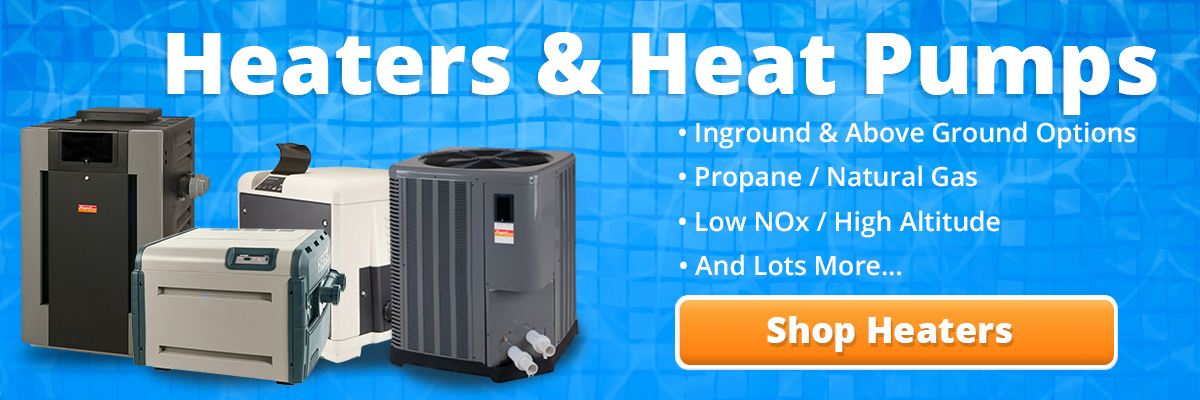Size - The required size of a heater depends on the size of your pool or spa and how fast you want to heat up your pool. In the northern states, you will probably want the larger heaters to compensate for the colder temperatures. Above ground, pools use heaters from 55K to 130K BTUs. In-ground pools and spa general run from 100K to 400K BTU. For an average 15' x 30' pool (15,000 gallons), a 300K BTU heater would raise your pool temperature 2 degrees per hour; a 400K BTU heater, 2.7 degrees per hour. For a 20' x 30' pool (20,000 gallons) the temperature rise for 300K and 400K heaters would be 1.5 and 2 degrees respectively. By contrast, these same heaters would raise the temperature of an average size spa 30 degrees in 35 and 20 minutes respectively.
Please click here to view our Sizing Your Pool Heater Blog 




Anonymous Posted: 3/22/2018
I also have just ordered my 3rd Raypak Heater. Same issues with the rust. I had premature wear out because I did not follow instructions on adding Chlorine to the pool. I put Chlorine tablets into my skimmer. And dumped the bags of Shock down the skimmer. This new heater, I ordered a Cupro Nickel Heater. And will be keeping my Chlorine tablets in a Pool Surface Floater container. I also will be diluting my shock in a bucket totally prior to adding.Reply
InyoPools Product Specialist Dennis R. Posted: 4/25/2016
Rusted out heater floor panel – According to a Raypak tech rep, the rusted floor panel was due to condensation which in turn was due to a failed Unitherm Governor. In Raypak’s words, “The Unitherm Governor inside the header helps reduce condensation from low inlet water temperatures. It automatically regulates the water flow to help keep the water temperature in the heat exchanger above 105°F. Both water temperature and water flow rate are controlled to eliminate condensation, sooting, and scale build-up that can shorten heater life”. The Unitherm Governor is often corroded by chlorine if the chlorine levels are allowed to exceed the normal operating limits. One way to determine if the Unitherm Governor has failed is to listen to the heater during operation. If the Governor has failed, you will hear sizzling when the water condensation drips on the heater tubes.Reply
Anonymous Posted: 4/18/2016
Good article, but IMO you forgot one other aspect that I feel is important: internal rust resistance. We bought a RayPak NG heater with our pool - it worked fine for years, but after just the first year I was very unhappy to see that the internal metal cabinet parts had already begun to rust. You could just tell they weren't going to last long. Well before the heat exchanger began leaking, parts of the floor panel underneath the burner ass'y had already completely rusted out. Nothing left but piles of "rust dust". You'd think that the manufacturer would at least try to make the cabinet parts somewhat rust resistant. Here you've got metal alternately exposed to extreme heat and outside moisture. Very disappointed with that design. Won't be buying RayPak, ever again.Reply
InyoPools Product Specialist Dennis R. Posted: 3/29/2016
Mike - Here is our link to LP to NG conversions kits. Talk with someone that has done these conversions before or read up on it. I'm told it is not hard but there is a chance of an explosion if it's not done correctly. Also check for any local code restrictions.Reply
Mike Posted: 3/28/2016
Hi,I am planning on building my own spa/hot tub. I see plenty of used pool heaters on Craig's List but they are all propane units. I have NG coming into my home. Is there a way to convert Propane to NG? Do I need to buy a different regulator?
I need to go as cheap as I can so any info you provide will be greatly appreciated.
thanks!
Mike
Reply
Mike Casey Posted: 9/30/2015
I us a Raypac natural gas 055B Spa heater to heat my 5000 gallon fish pond. I live in Denver Colorado which is a mile high. The unit is protected from the elements but only lasts about three years. I have gone through my third heater.There four major problems with the unit:
1. All of the sensors are too close to the flame and they are deteriorated over time by the heat.
2. The heat exchanger clogs up with soot and requires cleaning which is difficult, due to the construction of the unit.
3. The welds on the heat exchanger tend to leak and at that point the fins corrode.
4. A new heat exchanger costs $550, A new unit costs $750 so therefore every three years I buy a new unit.
I will be glad to entertain any suggestions.
Mike Casey
Reply
Anonymous Posted: 6/26/2015
Good article. It was helpful.Reply
ron Posted: 3/19/2015
cover all the key areas in a straight forward manner. would like links to pursue specific areas of interest in more detail. Well done, thanks!Reply
Anonymous Posted: 6/29/2014
Excellent article! New pool owner who knows virtually nothing of pool heaters and I am now comfortable purchasing a pool/spa heater thanks to this article!Reply
Anonymous Posted: 6/18/2014
Excellent article. Very informative and helpfulReply